Low Maintenance Plants for Every Brown Thumb
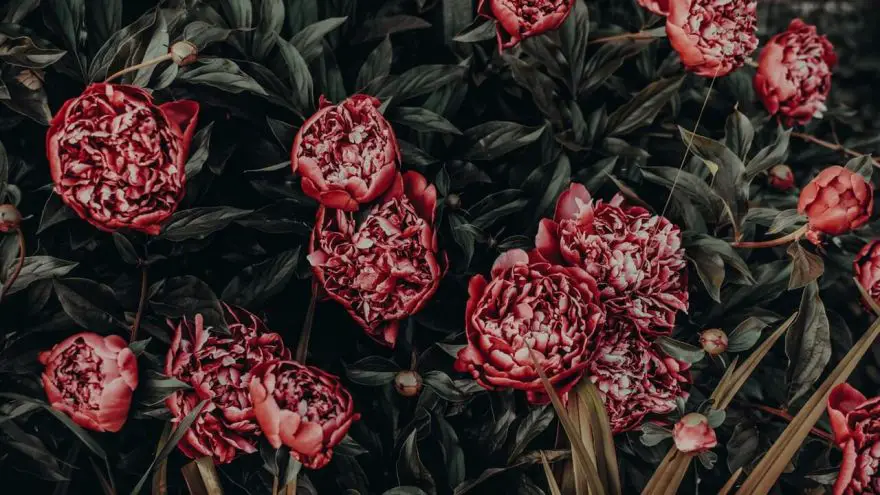 Low Maintenance Plants for Every Brown Thumb
thegearhunt.com
Low Maintenance Plants for Every Brown Thumb
thegearhunt.com
This is something that may vary from one climate to the next as well as from one season to the next, but there are quite a few plants that fall under the low maintenance category. There are basically 2 tricks to it. The first one is to choose plants that are suited for your area, and the second one is to give them the time they need to establish themselves.
If you follow those 2 main tips, you will be able to have at least a couple of undemanding, low maintenance plants that will provide blooms when they are in season. That doesn’t mean that you will have a NO maintenance garden though. However, the plants we will talk about here today will be hardy enough to allow you to enjoy the act of gardening as opposed to viewing it with trepidation.
Blazing Star
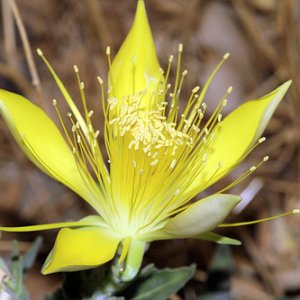 This plant is native to quite a few marshy areas, but despite that, it is surprisingly tolerant of drought and will grow in quite a few different kinds of soil. It blooms quite a bit and the flowers are spiky. Add that to the foliage that is grassy, and you will be adding a bit of textural interest in your garden. The Blazing star has a high content of nectar and with their tubular flowers, they act as magnets to the Monarch butterflies when they migrate during the fall.
This plant is native to quite a few marshy areas, but despite that, it is surprisingly tolerant of drought and will grow in quite a few different kinds of soil. It blooms quite a bit and the flowers are spiky. Add that to the foliage that is grassy, and you will be adding a bit of textural interest in your garden. The Blazing star has a high content of nectar and with their tubular flowers, they act as magnets to the Monarch butterflies when they migrate during the fall.
If you want to avoid staking, choose a low growing or compact variety. This plant will bloom from the middle of summer through the fall and the blooms can be white, pink, or purple depending on the variety.
Coneflower
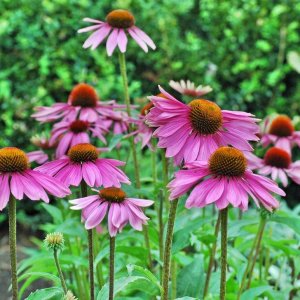 Not very long ago, the coneflower was known as the purple coneflower. However, nowadays you can find it in nearly every color in the rainbow, even some that are bold and electric. When it comes to hardiness, the originals still reign, but since they keep refining the newer ones, they tend to get better and better. The coneflower will bloom all summer long if you deadhead them. Other than that, this plant pretty much can hold its own with nothing but some sun and a bit of water.
Not very long ago, the coneflower was known as the purple coneflower. However, nowadays you can find it in nearly every color in the rainbow, even some that are bold and electric. When it comes to hardiness, the originals still reign, but since they keep refining the newer ones, they tend to get better and better. The coneflower will bloom all summer long if you deadhead them. Other than that, this plant pretty much can hold its own with nothing but some sun and a bit of water.
The coneflower blooms in the summer and comes in red, pink, yellow, orange, white, and purple varieties.
Coral Bells
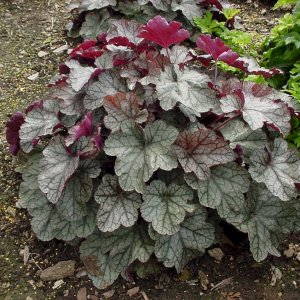 This is a plant that will dazzle in shade gardens. It got its name because the original plant featured dainty little flowers shaped like coral bells. The foliage was ok, but the main attraction was the abundance of flowers. Nowadays, the plant is often grown for the variegated and colorful leaves. It comes in a variety of colors including mottled green, butterscotch, purple, and even stripes. Most of the varieties will do well in a bit of shade where their color that spans the season will be quite a welcome sight.
This is a plant that will dazzle in shade gardens. It got its name because the original plant featured dainty little flowers shaped like coral bells. The foliage was ok, but the main attraction was the abundance of flowers. Nowadays, the plant is often grown for the variegated and colorful leaves. It comes in a variety of colors including mottled green, butterscotch, purple, and even stripes. Most of the varieties will do well in a bit of shade where their color that spans the season will be quite a welcome sight.
Despite the flowers being small, they are a favorite for hummingbirds.
This plant blooms in the late spring and into the early summer, but it is mostly grown for the foliage. The flowers can be red, pink, or white, and the foliage runs the gamut from lime green all the way to deep purple and can have quite a few splotches and swirls in the colors.
Foam Flower
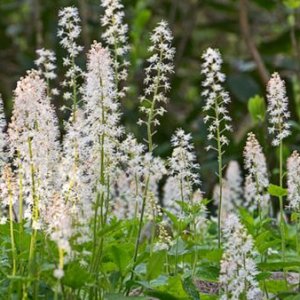 This is a well-behaved, delicate plant that will blanket the garden. It spreads rapidly, but it also accommodates the other plants that might be in the area because it goes around them. This is an ideal choice for anyone looking for ground cover, and it will provide interest all year long, and will even remain green in the snow.
This is a well-behaved, delicate plant that will blanket the garden. It spreads rapidly, but it also accommodates the other plants that might be in the area because it goes around them. This is an ideal choice for anyone looking for ground cover, and it will provide interest all year long, and will even remain green in the snow.
The foam flower features fuzzy spike-like flowers that shoot out right above its leaves that are maple-shaped. These velvety leaves will remain looking good all year. This is a plant that is capable of taking care of itself when it is planted in a woodland or shady area.
The flowers appear in the late spring and early summer and they are pink or white, depending on the variety.
Steel Blue Globe Thistle
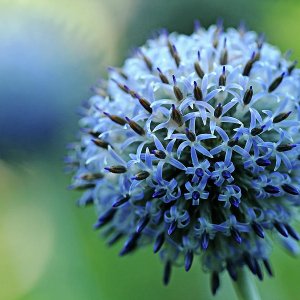 This is one plant that is just as hardy as it appears to be. This thistle is unlike other varieties of thistle because it isn’t invasive or weedy. It also doesn’t need any sort of division due to the long taproot it features not liking to be disturbed. This plant can seem like it is forever blooming due to its seed head being just as attractive as its blooms. This means that you won’t need to deadhead it and it will even do well in soil that is dry and of poor quality.
This is one plant that is just as hardy as it appears to be. This thistle is unlike other varieties of thistle because it isn’t invasive or weedy. It also doesn’t need any sort of division due to the long taproot it features not liking to be disturbed. This plant can seem like it is forever blooming due to its seed head being just as attractive as its blooms. This means that you won’t need to deadhead it and it will even do well in soil that is dry and of poor quality.
The globe thistle will remain in bloom for weeks on end, but its beauty doesn’t end with the blooms. It will remain looking good even while it fades and when it comes to dried flowers, it is a good choice due to the fact that it will nearly dry itself.
The blooms will appear in the early summer and remain until the early fall. They will be either white or blue.
Hosta
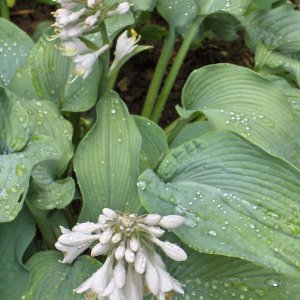 This is a versatile plant that shouldn’t be taken for granted. Hostas are perennials that don’t require a lot of care. If the slugs and deer didn’t adore them as much as they do, they would be a nearly perfect plant. They tend to grow the earliest in the season, and if you apply a deer deterrent a few times, this can lessen the damage done by the graceful creatures. The varieties with thicker leaves will be less attractive to those slimy slugs. Most of them will do well even in a bit of shade, but the varieties that feature golden leaves will do better in a good amount of sun.
This is a versatile plant that shouldn’t be taken for granted. Hostas are perennials that don’t require a lot of care. If the slugs and deer didn’t adore them as much as they do, they would be a nearly perfect plant. They tend to grow the earliest in the season, and if you apply a deer deterrent a few times, this can lessen the damage done by the graceful creatures. The varieties with thicker leaves will be less attractive to those slimy slugs. Most of them will do well even in a bit of shade, but the varieties that feature golden leaves will do better in a good amount of sun.
The Hosta will generally bloom in mid-summer with flowers that will be either white or purple.
Peonies
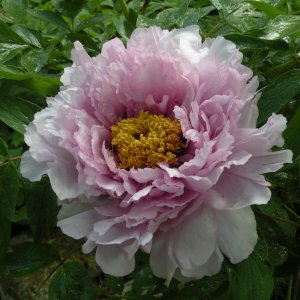 This is a flowering plant that is quite fragrant. You will want to touch the blooms and their growth habit is a bit on the carefree side. With all of that, is it any surprise that his flower is known as the Queen of the Garden?
This is a flowering plant that is quite fragrant. You will want to touch the blooms and their growth habit is a bit on the carefree side. With all of that, is it any surprise that his flower is known as the Queen of the Garden?
The peony is an old-fashioned perennial favorite that does best when you leave it alone. The double blossoms can be heavy enough to require staking though if there are no plants near enough for them to lean on. That being said, the varieties with single flowers will typically be able to hold their own heads up. The foliage is bushy and will look great throughout the season.
Peonies do best when you leave them right where you put them and if you divide them, they won’t adjust quickly. They can attract gray mold, and you should cut the foliage back and dispose of it when fall comes around. There are quite a few different varieties of this plant that you can choose from to suit the look of your garden.
The peony blooms in the late spring and early summer and those blooms are yellow, red, white, or pink, depending on the variety.
Russian Sage
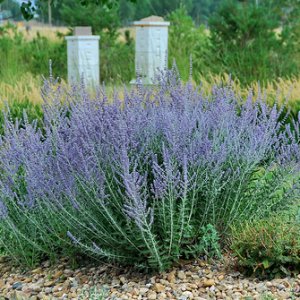 If you go with this plant, it will need good drainage and a lot of sun. If you give it these things it will reward you with a haze of blue that will get more vivid and brighter as its blossoms open. It has woody stems, but they can die all the way to the ground in climates that are colder. If you prune them down to around 8 or 10’’ in the early part of the spring, it will encourage a lot of new growth and blooms that can be profuse. This plant is also highly resistant to drought.
If you go with this plant, it will need good drainage and a lot of sun. If you give it these things it will reward you with a haze of blue that will get more vivid and brighter as its blossoms open. It has woody stems, but they can die all the way to the ground in climates that are colder. If you prune them down to around 8 or 10’’ in the early part of the spring, it will encourage a lot of new growth and blooms that can be profuse. This plant is also highly resistant to drought.
When it comes to pests, they don’t tend to like this plant. Even the deer will steer clear of it. You won’t need to divide it but will get quite a few volunteers.
Russian sage will bloom in the mid-summer through the fall and the colors will be blue or purple.
Sea Thrift
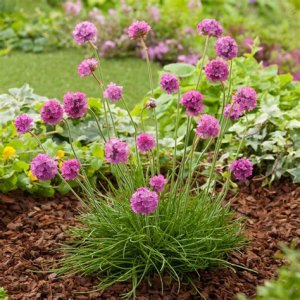 This is a flower that will start spring off with a burst of bold color. The foliage will resemble a simple tuft of grass, but don’t let that fool you. The flowers will soon demand your attention when they shoot up over the foliage with bright colors. The actual flowers resemble small clusters of alliums. You can deadhead them to get repeated blooms, and you can refresh the entire plant by cutting it down to its basal growth, but this isn’t a requirement.
This is a flower that will start spring off with a burst of bold color. The foliage will resemble a simple tuft of grass, but don’t let that fool you. The flowers will soon demand your attention when they shoot up over the foliage with bright colors. The actual flowers resemble small clusters of alliums. You can deadhead them to get repeated blooms, and you can refresh the entire plant by cutting it down to its basal growth, but this isn’t a requirement.
These plants are sweet looking, but they are truly quite hardy and able to grow in soil that is rocky and even in sea spray and high winds. They bloom in the spring and early summer and the bloom color can be white, red, lilac, rose, or pink.
Siberian Iris
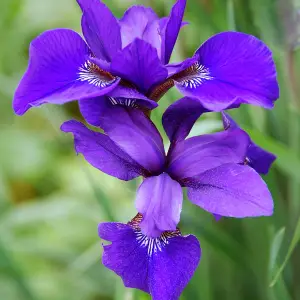 With this variety of the iris, you will get all of the beauty with only a little bit of care and attention. This is probably the most adaptable and attractive of irises. They have the typical leaf blades of the other irises, but unlike a lot of varieties, they won’t scorch or flop after they bloom. They can remain in their contrasting form even long after their blooms have faded.
With this variety of the iris, you will get all of the beauty with only a little bit of care and attention. This is probably the most adaptable and attractive of irises. They have the typical leaf blades of the other irises, but unlike a lot of varieties, they won’t scorch or flop after they bloom. They can remain in their contrasting form even long after their blooms have faded.
This plant can quickly spread when the conditions are moist, and they will require division when they become crowded, or you will get fewer flowers. However, that is about all of the attention they need from you. In warmer areas, they might even bloom again in the fall.
The Siberian iris will bloom in the late spring and the flowers will be white, purple, or blue.
Snake Plant
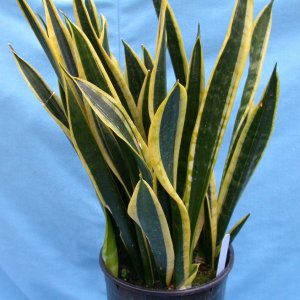 This plant is also known as the ribbon plant or the mother-in-law’s tongue. It is a succulent that features leaves that are waxy and thick. It adores being in pots and thrives on you ignoring it. It is the ideal plant for those who like to take 2-week vacations.
This plant is also known as the ribbon plant or the mother-in-law’s tongue. It is a succulent that features leaves that are waxy and thick. It adores being in pots and thrives on you ignoring it. It is the ideal plant for those who like to take 2-week vacations.
Day Lily
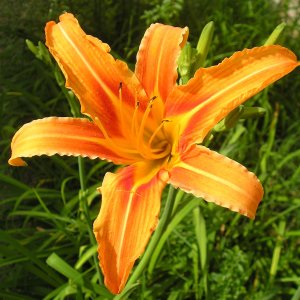
The day lily offers color that is vibrant and is a very low maintenance plant. In fact, it might just be the easiest plants to care for that you will ever have. This is a plant that will appear neat and tidy throughout the season and it will be covered in blooms from early summer through mid-summer. There are even quite a few varieties that will bloom more than once and even some that will have smaller blooms in the fall.
The actual plant will grow larger each year and you can eventually split it, but this will take a while. The only real maintenance it needs is for you to clear away the dead growth from last year. You can shear the plant all the way to the ground when fall arrives or you can clear it out by hand if you wait until the spring.
If you plant these near daffodils or tulips, they will just begin to bloom when the others are beginning to fade, so it will make your garden look nice for a longer period of time.
Spirea
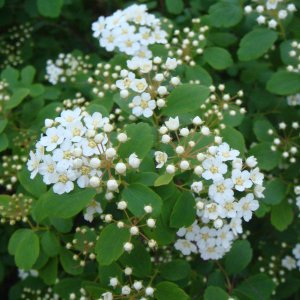 If you only want a single shrub in your yard or garden, it should be this one. This is a low maintenance shrub that will be gorgeous throughout the season.
If you only want a single shrub in your yard or garden, it should be this one. This is a low maintenance shrub that will be gorgeous throughout the season.
Spireas range in size from quite compact ones that are only about 3’ tall to ones that grow very large. The interesting thing about them is that they will flower beautifully during the warmer months and finish off the fall with excellent color.
It is very easy to keep Spireas looking great. You can prune them any time during the year, aside from when they are blooming, but they don’t really care how much you prune them. You can even just take a hedge clipper to them in the spring or fall to keep them in the shape you prefer. It only takes a few minutes to give them this annual haircut and you will be done with it and ready for the next season. A couple of the more popular varieties include the Gold Mound and the Little Princess.
No Maintenance Plants
Are you looking for plants that are truly no maintenance? If so, about the only type you will find will be some sort of evergreen. However, the ones we have discussed here today are very nearly no maintenance. The issue with a plant that doesn’t need any maintenance at all is that it tends to not be quite as pretty as the other types.
So, instead of going for no maintenance, if you stick with low maintenance, the rewards will be well worth the tiny bit of effort.
Sources
- You Tube, Low Care and Maintenance Indoor Plants
- Birds & Blooms, Top 10 Low Maintenance Perennials
- HGTV, Forgiving Houseplants
- DIY Network, Low Maintenance Plants for Easy Landscaping
















